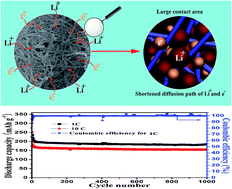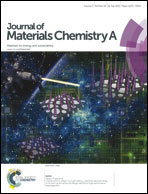Morphology-engineered and TiO2 (B)-introduced anatase TiO2 as an advanced anode material for lithium-ion batteries†
Abstract
Low capacity and poor rate capability are the critical disadvantages for the practical application of anatase TiO2 anode materials for lithium-ion batteries. In this work, we present an effective and facile strategy for improving the electrochemical performance of anatase TiO2 anode materials for lithium-ion batteries. In our strategy, besides designing a unique nanostructure, the introduction of a second phase, TiO2 (B), is also involved. As a result, the electrochemical properties of the as-prepared TiO2 (TiO2-400) with a hierarchical structure of micro/nanoparticles constructed by ultrafine nanowires with 3–8 nm width and several micrometers (μm) length, in terms of capacity, rate capability and cycling performance are significantly improved. A high reversible capacity of 207.1 mA h g−1 is obtained at 0.2 C after 150 cycles. Even after 1000 cycles, high reversible capacities of 186 and 155.4 mA h g−1 are delivered at 1 C and 10 C, respectively. Moreover, reversible capacities of 142.1 and 140 mA h g−1 can be obtained even at 20C and 25 C, respectively. It is suggested that this excellent electrochemical performance may make TiO2-400 a promising anode material for advanced lithium-ion batteries with high power density and ultra-long life.

- This article is part of the themed collection: 2015 Journal of Materials Chemistry A Hot Papers

 Please wait while we load your content...
Please wait while we load your content...